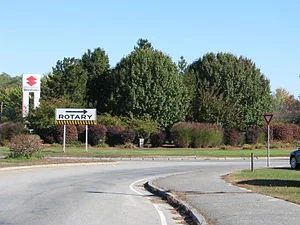From rotaries to roundabouts
From Robert Whitcomb's "Digital Diary,'' on GoLocal24.com:
New Englanders are familiar with “rotaries,’’ those confusing traffic circles infamous for creating confusion and accidents, albeit most of them minor. But now Massachusetts, which has more than 100 rotaries, is replacing them with “roundabouts” (a very English-sounding name).
As The Boston Globe reported: “The lack of organization on a rotary was both its beauty – cars could move quickly through them if the traffic was light, barely touching the brakes – and its chief problem, especially as traffic volumes swelled over the decades.’’ To read The Globe’s story, please hit this link:
https://www.bostonglobe.com/metro/2017/10/08/rotaries-disappear-favor-roundabouts/g8Znfv4XSyUokBSpEAyKaJ/story.html
So what’s the difference between a rotary and a roundabout? Here’s at least a partial explanation from City of Brooklyn Center:
“No lane changes occur within a roundabout. Except for vehicles that are turning right, entering a roundabout is a ‘crossing’ movement. A rotary is typically large, with entry speeds of 40 mph or higher. A roundabout is generally small; speeds are rarely more than 25 mph.’’
And from Northeastern University:
“Rotaries are typically a hundred to a few hundred feet across. Because the circle is so large, traffic moves very quickly. An important aspect is the tangential entries and exits. Speeds are 30-40 mph or higher because vehicles can drive straight onto the rotary with little or no deflection. The tangential entries also make it confusing for drivers.’’
“A modern day roundabout is very different from a rotary…. In a roundabout, the entering traffic approaches at a smaller angle than that of a rotary. Vehicles enter at an angle closer to 90 degrees. Drivers know they must yield before entering the roundabout. Because the diameter is smaller, and all cars must yield, the speed of traveling vehicles is approximately 25 mph or less.’’
“Another reason vehicles travel at slower speeds {in a roundabout} is that they are deflected. No vehicle can travel straight through the roundabout. All traffic is deflected around the center island and forced to only make right turns. This is much safer for vehicles as well as pedestrians and cyclists trying to cross.’’
Rotaries are traffic free-for-alls; roundabouts are a major organizational and safety improvement. The rotary is a bit of New England quaintness we can do without. Visitors to New England from elsewhere have often complained about rotaries, of which New England has the greatest density in America. Because it’s basically the oldest part of the country?
